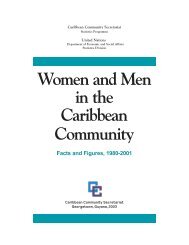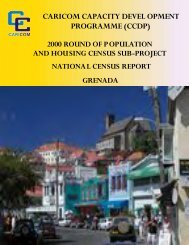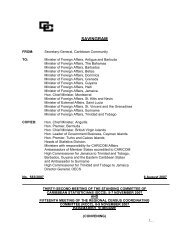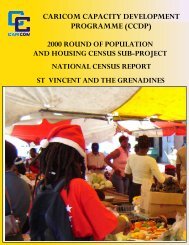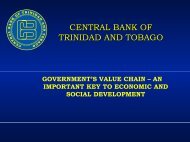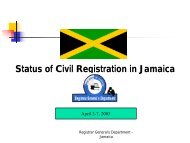The Case of Bermuda - CARICOM Statistics
The Case of Bermuda - CARICOM Statistics
The Case of Bermuda - CARICOM Statistics
Create successful ePaper yourself
Turn your PDF publications into a flip-book with our unique Google optimized e-Paper software.
2IntroductionAnnually, beginning the 18 th <strong>of</strong> December, 1999 the United Nations (UN) has been recognizingInternational Migrants Day. For the occasion countries are invited “… to observe the daythrough the dissemination <strong>of</strong> information on the human rights and fundamental freedoms <strong>of</strong>migrants, and through the sharing <strong>of</strong> experiences and the design <strong>of</strong> actions to ensure theirprotection.” 1On the 8 th anniversary <strong>of</strong> International Migrants Day in 2007, UN Secretary-General Ban Kimoon’sobservance message stated that this is:…an occasion that grows more meaningful with each passing year. Globalizationand the growing disparities in living conditions within and among States arecombining to increase the scale <strong>of</strong> cross-border migration worldwide. Currently,there are more people living outside their countries <strong>of</strong> birth than ever before, anestimated 200 million in 2007. 2Migration is the act or process <strong>of</strong> people moving from one geographical location to another.<strong>The</strong>re are two types <strong>of</strong> migration – internal migration and international migration. Internalmigration is the movement <strong>of</strong> people within a country, while international migration is thechange from the country <strong>of</strong> usual residence (where a person normally spends the daily period <strong>of</strong>rest), to reside in another. It is important to refine these distinctions between types <strong>of</strong>‘migration’ as the time element plays a crucial role in determining whether persons who travelinternally and internationally are visitors or residents. Migration excludes temporary (less than12 months) travel for visiting, vacation, or business purposes. In an effort to distinguish betweencommuters who cross international borders, the UN developed the concept <strong>of</strong> long-and shorttermmigrant (box below).DefinitionsLongtermmigrantShort-termmigrantA person who moves to a country other than that <strong>of</strong> his or her usual residence for aperiod <strong>of</strong> at least a year (12 months), so that the country <strong>of</strong> destination effectivelybecomes his or her new country <strong>of</strong> usual residence. From the perspective <strong>of</strong> thecountry <strong>of</strong> departure, the person will be a long-term emigrant and from that <strong>of</strong> thecountry <strong>of</strong> arrival, the person will be a long-term immigrant.A person who moves to a country other than that <strong>of</strong> his or her usual residence for aperiod <strong>of</strong> at least 3 months but less than a year (12 months), except in cases where themovement to that country is for purposes <strong>of</strong> recreation, holiday, visits to friends andrelatives, business, medical treatment, or religious pilgrimage. For purposes <strong>of</strong>international migration statistics, the country <strong>of</strong> usual residence <strong>of</strong> short-term migrantsis considered to be the country <strong>of</strong> destination during the period they spend in it. 31 http://www.un.org/depts/dhl/events/migrants/2 http://www.un.org/apps/sg/sgstats.asp?nid=29223http://unstats.un.org/unsd/publication/SeriesM/SeriesM_58rev1E.pdf



